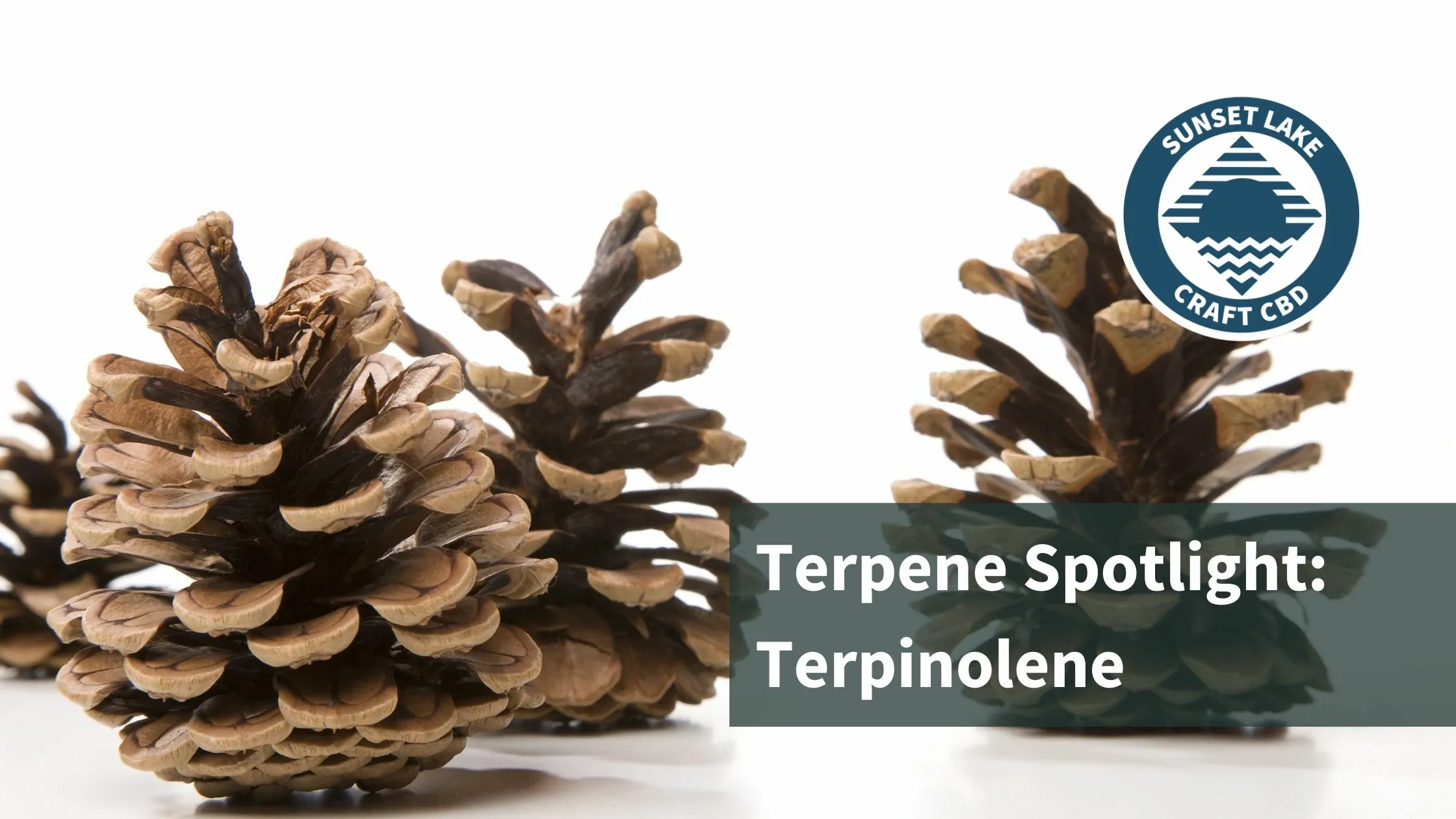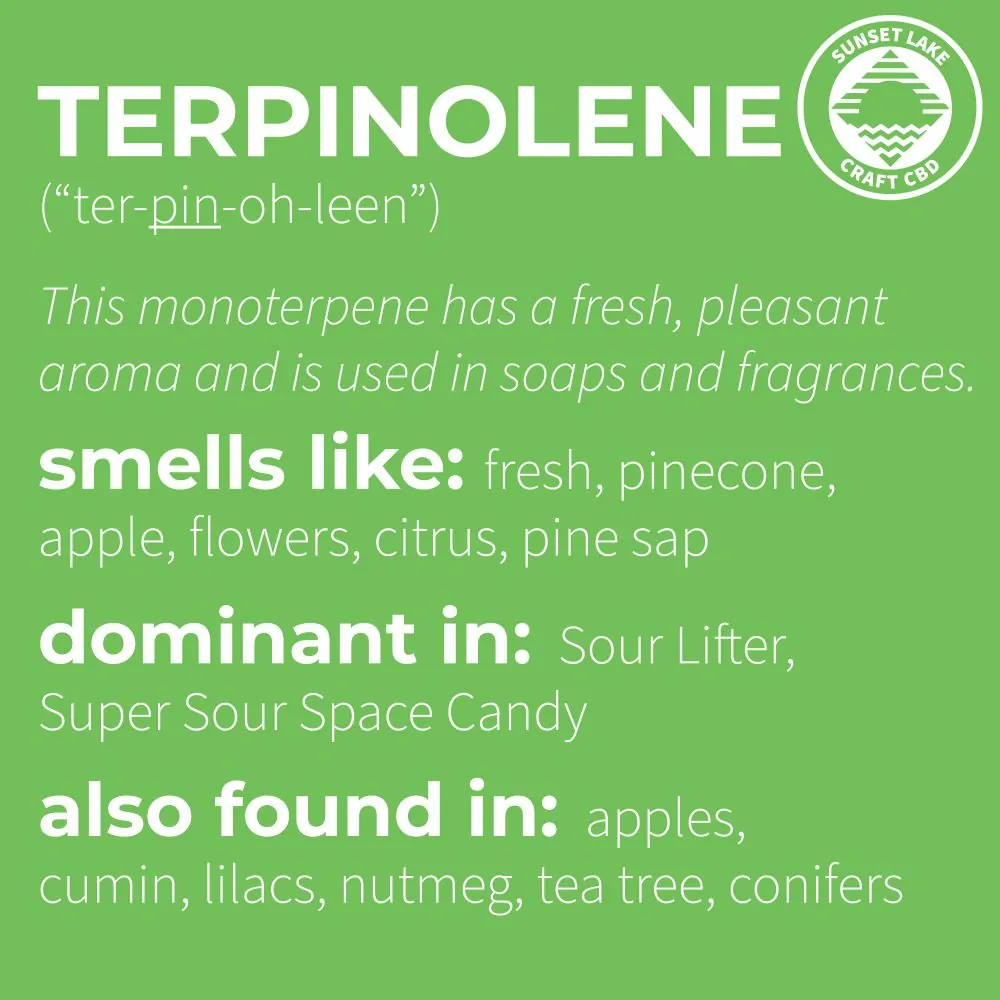No products in the cart.
Terpene Spotlight: Terpinolene

As research explores all the potential benefits of Terpinolene, there is an increased public interest in learning more about the active compounds beyond just CBD and THC. Terpenes feature prominently in the discussion about how hemp can make you feel and play a major role in how hemp smells.
There are dozens of terpenes found in hemp flowers, and one of the least common terpenes is called terpinolene (“ter-pin-oh-leen”). But just because it’s not typically found in high concentrations doesn’t sideline it. In fact, some of Sunset Lake CBD flower cultivars like the 2021 Sour Lifter and 2021 Super Sour Space Candy are quite high in terpinolene!
What We’ll Cover
- What is terpinolene?
- Where terpinolene can be found in nature
- What research says about its potential benefits
What Are Terpenes?
Before jumping, let’s take a moment to explore what terpenes are in general. Terpenes are aromatic, volatile hydrocarbons found in many plants and animals. Terpene molecules are composed of small units called isoprenes and are classified by the number of isoprene units they contain. The most common terpenes are monoterpenes, sesquiterpenes, and diterpenes.
Terpenes play a key role in the scent of many plants. You may already be familiar with many terpenes but might not know their names.
Examples of Terpenes:
- Pine trees contain a lot of (what else) pinene.
- Lavender gets its relaxing scent from linalool.
- Hops and mangos get their aroma from myrcene.
What is Terpinolene?
Is a monoterpene comprised of just two isoprene units. This sweet-smelling terpene is found in apples, cumin, lilacs, nutmeg, conifer trees, tea tree (Melaleuca alternifolia), and hemp. It is also one of the components of turpentine, a product made from fir trees.
Fun fact: The word “terpene” is derived from the word turpentine, which is composed primarily of pinene, carene, camphene, dipentene, and terpinolene.
Has a fresh, sweet chemical smell with notes of pinecones, apples, citrus, flowers, and pine sap.
Is typically found in small concentrations in hemp flowers and is rarely the dominant terpene in a given cultivar. Hemp cultivars feature a wide array of terpenes, and the dominant terpene is the one with the highest concentration in that specific cultivar. Below, we will discuss which of our hemp cultivars have terpinolene as the dominant terpene based on laboratory analysis.
Where Can Terpinolene Be Found in Nature?
It is not only found in hemp but also in various other plants and products. This terpene is quite versatile and widespread in nature.
Natural Sources:
- Apples: Contributes to the fresh, crisp aroma of apples.
- Cumin: This spice, common in many global cuisines, contains terpinolene, adding to its complex flavor profile.
- Lilacs: These fragrant flowers owe part of their delightful scent.
- Nutmeg: Known for its warm, spicy aroma, nutmeg also contains terpinolene.
- Conifer Trees: This is a significant component of the fresh, piney scent of coniferous trees.
- Tea Tree (Melaleuca alternifolia): Commonly used for its medicinal properties, tea tree oil contains terpinolene.
- Turpentine: This product, derived from the resin of fir trees, is rich in terpinolene.
What is Terpinolene Used For?
Is used in many consumer goods like soaps, cosmetics, and perfumes. Aside from commercial uses, there is currently a wide array of ongoing research into how it affects the human body.
Potential Benefits of Terpinolene:
- Antioxidant: This has been studied for its potential to neutralize free radicals, which can cause cellular damage and contribute to aging and various diseases.
- Sedative: Some studies suggest that terpinolene may have sedative properties, making it useful for promoting relaxation and sleep.
- Anti-inflammatory: Terpinolene’s anti-inflammatory effects could be beneficial in managing conditions like arthritis and other inflammatory disorders.
- Antibacterial & Antimicrobial: Terpinolene has shown the potential to inhibit the growth of bacteria and other microbes, which makes it a valuable ingredient in personal care products and disinfectants.
- Antifungal: As part of tea tree oil, terpinolene contributes to its antifungal properties, helping to treat conditions like athlete’s foot and fungal nail infections.
- Larvicide: Terpinolene has been researched for its potential use as a larvicide, which could help control insect populations.
- Insecticide: Its insecticidal properties make terpinolene a potential natural alternative to synthetic insecticides.
While research is ongoing, the jury is still out on what potential benefits terpinolene can offer.
Research and Studies of Terpinolene:
The scientific community continues to investigate the various properties and potential health benefits of terpinolene. Numerous studies have been conducted to explore its effects on human health and its practical applications.
- Antioxidant Properties: A study published in the Journal of Agricultural and Food Chemistry highlighted terpinolene’s ability to act as an antioxidant, which could be beneficial in preventing oxidative stress-related diseases.
- Sedative Effects: Research in the Journal of Natural Medicines suggests that terpinolene may have a calming effect, making it a potential natural remedy for insomnia and anxiety.
- Anti-inflammatory Benefits: Findings in the European Journal of Pharmacology indicate that terpinolene has significant anti-inflammatory properties, which could help in treating inflammatory conditions.
- Antimicrobial Activity: Studies in the International Journal of Food Microbiology have shown that terpinolene can inhibit the growth of various bacteria and fungi, supporting its use in food preservation and safety.
Sunset Lake CBD Cultivars:
Our hemp cultivars naturally contain a wide range of terpenes. We send samples of our hemp flowers to a third-party laboratory for testing to determine their terpene composition*. Here are our top cultivars that feature terpinolene as their dominant terpene:
- Super Sour Space Candy: This cultivar contains 1.06% terpinolene, giving it a unique aroma and potential health benefits.
- Sour Lifter: With 0.59% terpinolene, this cultivar also stands out for its distinct terpene profile.
*Note: the percentage of terpenes is reported on a by-weight basis.
Comparing Sunset Lake CBD with Competitors
When comparing Sunset Lake CBD’s terpinolene-rich cultivars with those of our competitors, it becomes clear that we offer some of the highest concentrations of this unique terpene. Many other brands do not provide detailed terpene profiles or laboratory analyses, making it difficult for consumers to understand what they are purchasing.
FAQs
- What are terpenes?
Terpenes are aromatic compounds found in many plants and some animals, playing a key role in their scent and potential therapeutic effects.
- Where can terpinolene be found naturally?
It is found in apples, cumin, lilacs, nutmeg, conifer trees, tea trees, and hemp.
- What are the potential benefits of terpinolene?
May have antioxidant, sedative, anti-inflammatory, antibacterial, antimicrobial, antifungal, larvicidal, and insecticidal properties.
- Which Sunset Lake CBD cultivars are high?
Super Sour Space Candy (1.06% terpinolene) and Sour Lifter (0.59% terpinolene) are Sunset Lake CBD cultivars high in terpinolene.
- How are terpene concentrations in hemp flowers measured?
Terpene concentrations in hemp flowers are measured by weight and determined through third-party laboratory testing.

